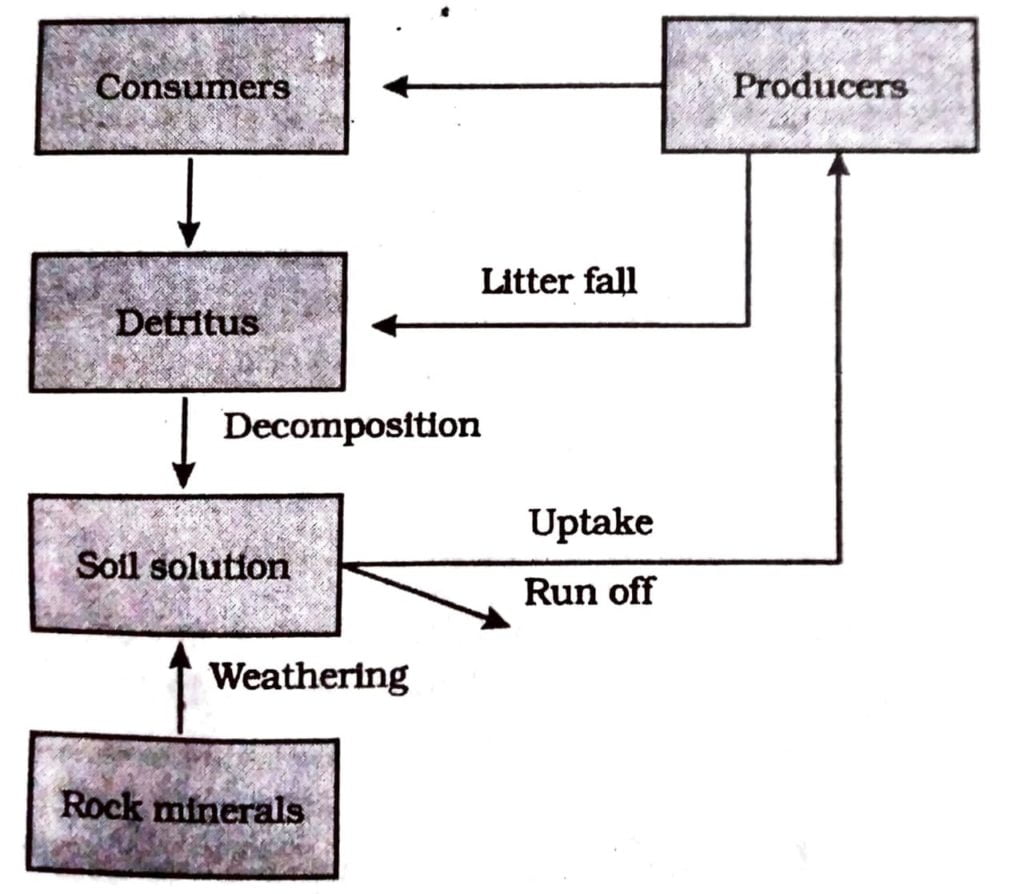Class 12 Biology Chapter 14 Ecosystem The answer to each chapter is provided in the list so that you can easily browse through different chapters Assam Board HS 2nd Year Biology Chapter 14 Ecosystem Question Answer.
Class 12 Biology Chapter 14 Ecosystem
Also, you can read the SCERT book online in these sections Solutions by Expert Teachers as per SCERT (CBSE) Book guidelines. These solutions are part of SCERT All Subject Solutions. Here we have given Assam Board Class 12 Biology Chapter 14 Ecosystem Solutions for All Subjects, You can practice these here.
(E). Short Answer Question 3 Marks Each :
Q.1. What is productivity? How the productivity of an ecosystem is expressed?
Ans : The rate of biomass production is known as productivity. It is expressed in terms of g²yr¹ or (KCalm²) Yr¹ to compare the productivity of different ecosystems.
Primary productivity is defined as the amount of biomass or organic matter produced per unit area over a time period by plants during photosynthesis. It is expressed in terms of weight (g²) or energy (Kclam²). It can be divided into two types – Gross Primary Productivity (GPP) and Net Primary Productivity (NPP).
Gross Primary Productivity (GPP) is the rate of production of organic matter during photosynthesis.
Net Primary Productivity (NPP) is the available biomass for the consumption to heterotrophs. It can be expressed by the following equation – GPP – R = NPP. R = Respiratory Loss.
The rate of formation of new organic matter by consumers is known as Secondary Productivity.
Q.2. Write briefly on the factors controlling primary productivity of ecosystem.
Ans : In an ecosystem green plants are the primary producer. The primary productivity depends on the plant species inhabiting a particular area. It also depends on a variety of environmental factors like solar energy, temperature, animals, soil, other microorganisms present in the atmosphere, availability of nutrients etc. Among these solar energy is the main factor. It is because this is the only source of energy which plants utilise. Without this energy plants cannot survive.
Among the abiotic factors soil, water, temperature, carbon dioxide etc. are very essential for the process of photosynthesis. Moreover, micro-organisms that play an important and great role in the process of primary productivity. Several microorganisms act on the minerals present in the soil and causes cyclical changes in them and transforms them into several essential elements necessary for the growth and development of the plant. Thus the primary. productivity of plants depends on several factors biotic and abiotic factors.
3. Diagrammatically explain decomposition cycle in a terrestrial ecosystem.
Ans : The breakdown of complex organic matter into inorganic matter is called đecomposition which is done by decomposer.
The bit of dead organic remains such as bark, leaves, flowers, fruits, dead remains of the animal and fecal matter present in any ecosystem is known as detritus.
The organisms which feed upon the detritus is called the detritivorous.
All freshly fallen dead plants and animals matter is known as litter. The partially decomposed litter is called duff. Several water soluble inorganic substances percolate into the deeper layers of soil along with rain or irrigation water, it is known as leaching.
The normal biological process of decay by bacteria, fungus etc. results in the formation of finely divided amorphous dark coloured soil with minerals, it is called humus. The process leading to formation of humus is called Humification. The humus further degraded by some microbes and release organic matter and the process is called mineralisation.

Q.4. “Flow of energy in ecosystem follows the laws of thermodynamics”, explain the statement.
Ans : Energy flow is passage or flow of energy from one trophic level to another trophic level and is unidirectional.
(i) Capture of energy : Sun is the only source of energy for all ecosystems on earth. Out of the total incident solar radiation, only 50 percent is photosynthetically active radiation (PAR). Plants capture 2-10 percent of the PAR to form organic matter. The net primary productivity is available to the rest of the ecosystem.
(ii) Passage of herbivores : Herbivores are dependent for their food on producers. In addition to organic matter or food, its contained energy becomes available to herbivores. However, only 10% of energy is stored in herbivore biomass. The remaining being lost to decomposers or waste organic matter or dissipated as heat.
(iii) Passage to primary carnivores : Only 10 percent of herbivores biomass energy is used by primary carnivores. The remaining dissipated as heat, lost to decomposers.
(iv) Passage secondary carnivores : Only 10 percent of the biomass energy available at the previous trophic level (primary carnivores) is available to the secondary carnivores.
(v) converted into dead biomass that serves as an energy source of Energy of decomposes : The utilised net primary production is decomposers.
Q.5. What is food chain? Describe the two basic types of food chain with examples.
Ans : In an ecosystem generally sun is the only source of energy. The autotrophs like plants etc. fix the sun radiant energy, to make food from simple inorganic materials and convert it into chemical energy. All organisms are dependent for their food on plants directly or indirectly. So animals i.e. herbivores feed on plants and these herbivores are eaten by the carnivores form a food chain.
The energy trapped by the producer hence is passed on to the primary consumer and then to the secondary consumer. Ultimately this energy goes to the decomposers. The food chain or web formed is due to this interdependency of organisms. There are mainly two basic types of food chains Grazing Food Chain
(i) Grazing Food Chain (GFC) : This type of food chain starts at the producer level and completes at the decomposer level. This type of food chains have so many levels like- producer, herbivore, carnivore and at last the decomposers. Here in each level 90 percent of the total energy is consumed. For example : Grass – Deer- Tiger.
(ii) Detritus Food Chain (DFC) : It begins with dead organic matter. It is made up of decomposers which are heterotrophic like fungi and bacteria. They meet their energy requirements by degrading detritus, with the help of some digestive enzymes secreted by them, into simple inorganic materials which are subsequently absorbed by them.
Q.6. Where do you get inverted pyramid? Describe briefly an inverted pyramid of number.
Ans : Generally, almost all the pyramids found in ecosystem are upright but there are exception.
The pyramid of biomass in sea is inverted because the biomass of fishes for exceeds that of phytoplankton. In general producers are more in number and biomass than the herbivores and herbivores are more in number and o energy at lower trophic level is always biomass than the carnivores. Also. more than at a higher level.
But the number of insects feeding on a big tree is less than the number of birds feeding on the insects. Similarly the number of birds feeding on the insect eating small birds are more in number. So depending on this if a pyramid is made it will form an inverted pyramid.
| Sl. No. | CONTENTS |
| Chapter 1 | Reproduction in Organisms |
| Chapter 2 | Sexual Reproduction in Flowering Plants |
| Chapter 3 | Human Reproduction |
| Chapter 4 | Reproductive Health |
| Chapter 5 | Principles of Inheritance and Variation |
| Chapter 6 | Molecular Basis of Inheritance |
| Chapter 7 | Evolution |
| Chapter 8 | Human Health and Disease |
| Chapter 9 | Strategies for Enhancement in Food Production |
| Chapter 10 | Microbes in Human Welfare |
| Chapter 11 | Biotechnology: Principles And Processes |
| Chapter 12 | Biotechnology and its Applications |
| Chapter 13 | Organisms and Populations |
| Chapter 14 | Ecosystem |
| Chapter 15 | Biodiversity and Conservation |
| Chapter 16 | Bioresources of Assam |
| Chapter 17 | Environmental Issues |
Q.7. Describe the primary succession in water.
Ans : In primary succession in water the pioneer species are the small phytoplanktons. During the course of time they are replaces by free floating angiosperms then by rooted hydrophytes, sedges, grasses and finally the trees. The climax community formed as a result of this succession in a forest. With the time the water body is converted into land.
Q.8. Explain the carbon cycle.
Ans : After water, carbon constitute 49 percent of dry weight of organism. Carbon dioxide is the principal source of inorganic carbon for all organisms. Green plants absorb this gas and through a complex process convert it into carbohydrate. Hěterotrophs utilise this carbohydrate as food and convert it into other forms of complex organic compounds. During the process of breaking down of food in the body of heterotrophs carbon dioxide is liberated which goes back into the atmosphere. Decomposers also contribute substantially to carbon dioxide pool by their processing of waste materials or dead organic matter of land or oceans. Some amount of the fixed carbon is lost to sediments and removed from circulation. Burning of wood, forest fire, volcanic activity has significantly increase the rate of releąse of carbon dioxide. Thus carbon dioxide circulates from inorganic state (atmosphere) to organic state (timing organism) and returns to the inorganic state again for reuse.
Q.9. What is nutrient cycling? What are the different types of nutrient cycling? Give one example of each of them.
Ans : Nutrients are never lost from the ecosystems. They are recycled i.e. they circulate in the biosphere in circular path entering into the living system by converting themselves as organic compounds and then on death of the organisms the organic compounds are mineralised to return the elements into the environments. So, the movement of nutrient elements through the various components of an ecosystem is called nutrient cycling. It is also known as biogeochemical cycle.
Nutrient cycles are of two types :
(a) Gaseous. and
(b) Sedimentary.
(a) Gaseous Cycle : The reservoir of gaseous type of nutrient cycle (v) like – nitrogen cycle, carbon cycle exist in the atmosphere.
(b) Sedimentary Cycle : For Sedimentary cycle like- Sulphur cycle and phosphorus cycle the reservoir is located in earth’s crust.
Q.10. Describe the phosphorus cycle.
Ans : Phosphorus is a major constituent of biological membranes, nucleic acids and cellular energy transfer system of organisms. The natural reservoir of phosphorus is rock which contain phosphorus in the form of phosphates. When rocks are weathered, minute amounts of these phosphates dissolve in soil solution and are absorbed by the roots of the plants. Herbivores and other elements obtain this element from plants. The waste products and dead organisms are decomposed by phosphate solubilizing bacteria releasing phosphorus. Atmospheric insect of phosphorus through rainfall are much smaller than carbon cycle and gaseous exchange of phosphorus between organism and environment are also negligible.

Q.11. Write briefly on ecosystem services.
Ans : From the beginning man has been dependent on nature for his existence. The nature has been kind enough to provide him healthy air, water, good soil, fibres, wood, energy resources and many more. Besides these, ecosystems provide suitable habitats for wild life, have mechanisms for regenerating fertile soils, mitigate the effects of pollution, recycle the minerals so that they are available to the organisms for their healthy growth and development. All the above benefits that we get from the ecosystem are referred to as ecosystem services. We get them free of cost in the ecosystem, and therefore, as human nature is, we have exploited them without considering the need and importance of their preservation.

Hi, I’m Dev Kirtonia, Founder & CEO of Dev Library. A website that provides all SCERT, NCERT 3 to 12, and BA, B.com, B.Sc, and Computer Science with Post Graduate Notes & Suggestions, Novel, eBooks, Biography, Quotes, Study Materials, and more.


